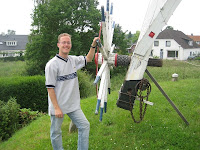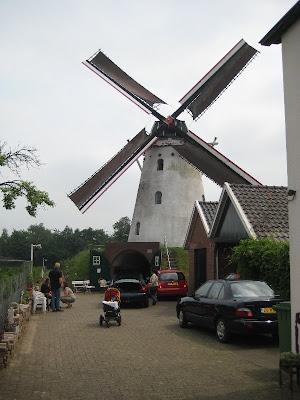
8" x 12" Watercolor painting of Dutch Windmill by Roland Lee. This big Stellingmolen at the Open Lucht Museum in Arnhem Netherlands has its sails trimmed and operating. I had a chance to study this molen up close and see them demonstrate putting the canvas sails on and taking them off.
Click here for more information about this painting of Stellingmolen in Holland
HOW DOES A WINDMILL WORK?
Admittedly, this is from someone who isn't really qualified to speak on the subject, but in general this is how the windmill (molen) works. The four-bladed Sails
 (sometimes called wings by the locals) are angled so they catch the wind, operating a gear mechanism inside the cap which turns a vertical shaft. This shaft is harnessed to huge grinding stones for milling grain. The windmills were also often used in Holland to operate an Archimedes Screw for pumping water. Although used since the 12th century, today most windmills in Holland are static and kept only for historical purposes.
(sometimes called wings by the locals) are angled so they catch the wind, operating a gear mechanism inside the cap which turns a vertical shaft. This shaft is harnessed to huge grinding stones for milling grain. The windmills were also often used in Holland to operate an Archimedes Screw for pumping water. Although used since the 12th century, today most windmills in Holland are static and kept only for historical purposes.  We were fortunate to have a private tour of De Volharding windmill in Zeddam Holland, owned by Remco Harmsen and Mara Waszkiewicz. It is fascinating to see the inner workings with the huge mechanisms and multi-ton millstones. Remco took me up a narrow ladder into the cap to see huge wooden-tooth gears. I was surprised that it only took a slight wind to turn them and they were so smooth and quiet--No creaking or groaning as I expected.
We were fortunate to have a private tour of De Volharding windmill in Zeddam Holland, owned by Remco Harmsen and Mara Waszkiewicz. It is fascinating to see the inner workings with the huge mechanisms and multi-ton millstones. Remco took me up a narrow ladder into the cap to see huge wooden-tooth gears. I was surprised that it only took a slight wind to turn them and they were so smooth and quiet--No creaking or groaning as I expected.  One day Remco hopes to have the windmill completely restored and operating on a regular basis. We were lucky to happen on this one while it was in motion, as most are not.
One day Remco hopes to have the windmill completely restored and operating on a regular basis. We were lucky to happen on this one while it was in motion, as most are not. The wooden lattice structures you see on the sails in paintings and photos are actually just the supports. In order to actually catch the wind, the miller must stretch canvas over the latticework and "trim" up the sails to best capture the wind power. This is done by braking the sails and rigging them up (or down) one sail at a time. It's fun to watch the process, and see the big wings in motion.
The wooden lattice structures you see on the sails in paintings and photos are actually just the supports. In order to actually catch the wind, the miller must stretch canvas over the latticework and "trim" up the sails to best capture the wind power. This is done by braking the sails and rigging them up (or down) one sail at a time. It's fun to watch the process, and see the big wings in motion.Click to see all my paintings from the Netherlands
Click to see all my travel sketchbook drawings from Holland

Hi Roland!
ReplyDeleteHello Roland, we are very pleased to find such a nice story about our windmil on the internet. It's been a while since you visited our mill and it's nice to see you appreciated the visit!
I like your painting on the Dutch Windmill!
Greetings from us, fam. Waszkiewicz & Harmsen